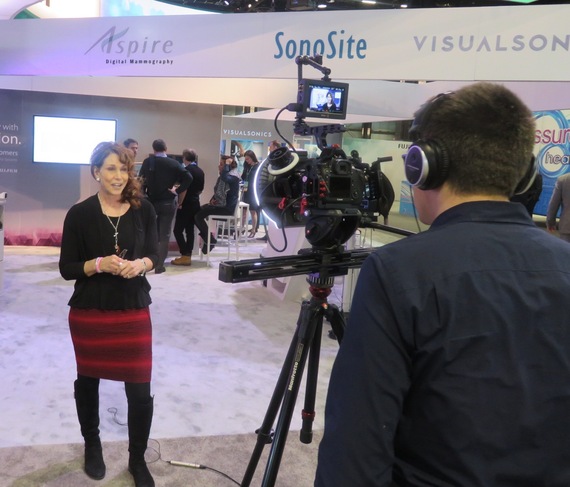In 2004, I was diagnosed with advanced stage 3C breast cancer. My 2.5 cm tumor, illuminated on ultrasound, was invisible by mammogram. Stunned that my yearly mammogram, just six weeks earlier, did not reveal my cancer, which metastasized to 13 lymph nodes, I questioned my brand new health care team as to why my cancer was discovered at such a late stage, given my strict allegiance to my yearly mammograms for more than a decade. "What happened to the promise of early detection?" I exclaimed. Each of my doctors, in a nonchalant manner, reported that my dense breast tissue, which I never knew I had, masked my cancer for years. I also learned that my primary physician received a different and more detailed report of my 11 years of mammography findings from the radiologist, unseen by me -- the patient -- which reported my extremely dense breast tissue and its impact on limiting the sensitivity of my mammogram to detect cancer -- its sole purpose. Unsatisfied with the responses from my health care providers, I scoured the scientific literature and uncovered more than a decade of research concluding that dense breast tissue is the strongest predictor of the failure of mammography to find cancer. I was horrified that my breast tissue composition, which could directly affect my breast health and subsequent life outcomes, known by my health care providers for a decade, was never disclosed to me.
Six months after Connecticut became the first state in the nation to mandate density reporting to the patient, I was invited to the Radiological Society of North American's Annual 2009 Assembly (RSNA) to address an elite group of radiologists whose facilities were selected as one of the multi-center sites to participate in the SOMO-INSIGHT study by U-Systems Inc. The goal of the study was to evaluate the sensitivity of automated breast ultrasound as an adjunct screening for women with 50 percent or greater dense tissue. The RSNA annual meeting, which has convened for more than 100 years, brings together the radiology industry, providing a forum to discover new research and innovative technologies for improved patient outcomes. In my three decades as an educator, I presented at professional conferences across the country but I never experienced such a large assembly in a field that was basically foreign to me, other than my participation as a consumer in the use of imaging technology.
In the 10th floor hotel suite in Chicago, I relived my patient story of my advanced stage cancer diagnosis, despite never missing an annual mammography appointment. I illustrated to the key opinion leaders that the greater shock, other than my advanced breast cancer diagnosis, was discovering that a critical piece of information about my breasts, while known by my health care providers for a decade, was kept from me. I was convinced after reading the decade of research that preceded my missed, delayed and advanced cancer, that my story of missed cancer and thus a delayed later stage diagnosis, represented innumerable women across this country and the globe. My legislative advocacy was birthed when my health care providers refused to disclose density to their other patients, claiming it was not the standard of care. My objective was to take the years of information in the medical journals about dense breast tissue to the examining room, giving every patient an opportunity to become equal partners in their breast screening surveillance which could materially affect their life. Rejected by my doctors, I turned to the legislature.
Connecticut's pioneering density reporting law has led to an additional 23 state laws across this country, with another 10 states considering reporting laws in 2016. The discussions of the impact of dense breast tissue on screening reliability have accelerated since my first RSNA meeting 6 years ago. Dense breast tissue is no longer reserved solely for the scientific journals, as it is a popular topic of discussion in the popular media. More patients and the general public are educated about dense breast tissue, predominately because of the tsunami of state density reporting laws. Additionally, there are further studies that support screening beyond the mammogram for women with dense breast tissue in addition to added imaging technologies and software products, dedicated to solving the breast density screening challenge.
At this year's RNSA 2015, there were numerous posters, sessions and new technologies offering solutions to imaging the dense breasts. Sessions on the masking and causal risk of dense breast tissue were packed with interested providers. While the disclosure of dense breast tissue to the patient has empowered patients with information to dialogue with their breast health providers, we still have a long way to go to improve breast screening outcomes. We need to ensure that insurance coverage is not a barrier to giving women with dense breast tissue access to adjunct screening. Additionally, we must continue to educate first-line health care providers of women about dense breast tissue and its impact on the reliability of mammographic screening. We also need physician trade group organizations to join Are You Dense Advocacy, Inc. as we advocate for a federal standard of density reporting so every woman in this country has equal access to an Early Diagnosis. While detecting breast cancer early is not a cure, it will give more women an opportunity to prevent late stage disease upon first diagnosis and, in turn, decrease mortality.
